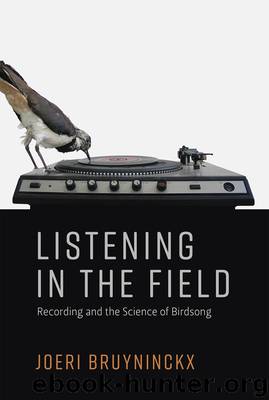Listening in the Field by Bruyninckx Joeri;

Author:Bruyninckx, Joeri;
Language: eng
Format: epub
Tags: Sound recording; Birdsong; Ornithology; Field science; Bodily practices; Auditory culture; Entertainment; Broadcasting; Notation; Citizen science; Amateur science; Representation; Transnational; Ivory-billed Woodpecker; Sound notation; Professionalization; Community; Diagrams; Music; Microphone; Recording industry; Fidelity; Ludwig Koch; Cornell Laboratory of Ornithology; Parlophone; Objectivity; Library of Natural Sounds; Magnetic tape recorder; Knowledge commons; Sociology of collaboration; Copyright; BBC; Sound spectrograph; Animal behaviour; Bioacoustics; Noise; Scientific object; Image; Bodily practice
Publisher: MIT Press
Published: 2018-04-26T16:00:00+00:00
Bioacousticians
After several years of testing, in 1949 the Cornell recordists abandoned their cumbersome disc cutters and sound-film recorders in favor of portable magnetic recorders. It took the academic community a few more years to grow attentive to the new analytic possibilities afforded by these technical innovations. When the twelve recordists that Kellogg brought together in 1951 at a small symposium during the American Ornithologists’ Union annual meeting played their recordings, they were more concerned with the technical difficulties of field recording than with its analytic implications. Amateur sound hunters Stillwell, North, and Davis were joined by professional scientists such as the Ohio entomologist Donald Borror, who had started taping birdsongs to teach his ornithology classes, or William R. Fish, who, as a chemist at the Naval Ordnance test station at China Lake, had been able to access commercial equipment to analyze his amateur recordings of California’s Bewick’s wren. Fish was one of the only presenters to argue that this combination of recording and analysis held “great promise as tools not only for the taxonomists but also for those engaged in studies of avian life histories.”21
When Fish organized a follow-up symposium in 1956 (the same year that the International Committee of Bioacoustics was established), the focus of the program had clearly shifted. The participants’ interest in recording birdsong had become professional and their approach systematic. Ohio ornithologist Wesley Lanyon, for instance, presented his research detailing the differences between the songs of eastern and western meadowlarks. Kellogg’s graduate student Robert Stein discussed the role of song as an isolating mechanism between different species in the genus Empidonax; his Cornell colleague William C. Dilger offered a behavioral study of how thrush species recognize each other by voice (Mayfield 1957, 86). In barely five years, the ornithologists had transformed the tape recorder from a pleasurable pastime into a way of generating meaningful data about more than the life histories of individual birds—by turning their microphones to particular species in specific locations, they appropriated sound recording as a tool in the study of topics of central concern to biology, such as speciation and variation.
This turn to the biological implications of birdsong studies followed a more general shift that had been taking place in ornithology since the 1930s. By the end of the Second World War, ornithology had expanded from a narrow specialization into a broad-based discipline. According to the existing historiography, a small group of young ornithologists transformed the field from a natural history discipline that had traditionally been divided between systematics (taxonomic studies) and field ornithology into a broad biological discipline concerned with questions of evolution and speciation (Haffer 2008; Johnson 2004). Such developments had been leading in the United States and Germany. But looking back in 1959, British ornithologist Reginald Ernest Moreau triumphantly declared a revolutionary change in the preceding two decades, which he saw reflected in the British ornithological journal Ibis. British ornithology, he argued, no longer seemed “inbred and isolated from the main currents of biological science,” but instead followed a
Download
This site does not store any files on its server. We only index and link to content provided by other sites. Please contact the content providers to delete copyright contents if any and email us, we'll remove relevant links or contents immediately.
| Amphibians | Animal Behavior & Communication |
| Animal Psychology | Ichthyology |
| Invertebrates | Mammals |
| Ornithology | Primatology |
| Reptiles |
Sapiens: A Brief History of Humankind by Yuval Noah Harari(14252)
The Tidewater Tales by John Barth(12608)
Mastermind: How to Think Like Sherlock Holmes by Maria Konnikova(7227)
Do No Harm Stories of Life, Death and Brain Surgery by Henry Marsh(6891)
The Thirst by Nesbo Jo(6827)
Why We Sleep: Unlocking the Power of Sleep and Dreams by Matthew Walker(6618)
Life 3.0: Being Human in the Age of Artificial Intelligence by Tegmark Max(5474)
Sapiens by Yuval Noah Harari(5294)
The Longevity Diet by Valter Longo(5019)
The Body: A Guide for Occupants by Bill Bryson(4974)
The Rules Do Not Apply by Ariel Levy(4861)
The Immortal Life of Henrietta Lacks by Rebecca Skloot(4525)
Animal Frequency by Melissa Alvarez(4395)
Why We Sleep by Matthew Walker(4360)
The Hacking of the American Mind by Robert H. Lustig(4318)
Yoga Anatomy by Kaminoff Leslie(4306)
All Creatures Great and Small by James Herriot(4232)
Double Down (Diary of a Wimpy Kid Book 11) by Jeff Kinney(4207)
Barron's AP Biology by Goldberg M.S. Deborah T(4097)
